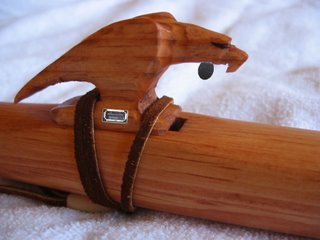Playing with other instruments
While the Native American Flute was designed as a solo lead instrument, it can be played along with other instruments. In fact this is one of the funnest activities at a flute circle. Note however, that you cannot tune the flute so it’s important that the other (tunable) instrument(s) tune to your flute. Drums, on the other hand, don’t need to be tuned, and that’s one of the reasons why playing with a drum is an easy choice. You should also be aware that you can typically blow an individual note 'sharper' by blowing harder. This is essentually what happens when you are using vibrato (the note wavers a little sharper, a little flatter as the air velocity varies with the vibrato). This is important to understand, because even with two flutes in the same key, the individual flute players can force the individual notes to be out of tune. Always 'test' the scale of two flutes together by running up/down the scale a few times. Use this interaction with the other flute player to establish the proper breath control to keep the flutes in tune while you play together. The better the two players are, the better they will be at controlling the tuning of the individual notes. This hint really says that the better flute player in the duet has the responsibity to (attempt to) control the tuning during the song.
Duets: Flute keys that play well together
Before you can play along with another flute player, for the best results either play two flutes that are in the same key, or choose from the list below to help harmonize the flutes.
Over the next couple of weeks, I am going to concentrate my Thursday Playing Tips to help provide you with some ideas/exercises to use when playing a duet with someone else. To begin with we have to review the concept of compatible keys. This theory follows the idea of the "circle of fifths". The table below outlines which "keys" harmonize with other keys. While the suggestion of "lower key" and "higher key" is a recommendation, you can easily swap the designation - it's merely a suggestion.
| Low Flute | High Flute |
|---|
| C | G |
| C# | G# |
| D | A |
| D# | A# |
| E | B |
| F | C |
| F# | C# |
| G | D |
| G# | D# |
| A | E |
| A# | F |
| B | F# |
 This Playing Tip is licensed under a Creative Commons Attribution-NonCommercial-ShareAlike 2.5 License.
This Playing Tip is licensed under a Creative Commons Attribution-NonCommercial-ShareAlike 2.5 License.

